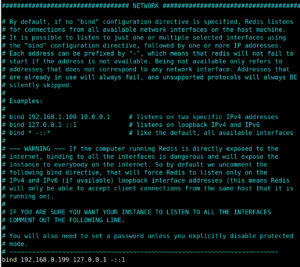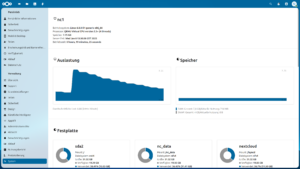Mit Hilfe dieser Anleitung, resultierend aus unserem Proxmox-Lab, installieren Sie zwei HAProxy-Server sowie zwei keepalived-Instanzen, zwei Webserver (nginx) für Nextcloud, einen zentralen Datenbank- und Redis-Server sowie einen NFS-Server auf Ubuntu 24 LTS oder Debian 12 (x86_64, kein ARM!).
- Server-/IP-Übersicht
- Installation HAProxy, hatop und keepalived
- Installation Webserver (nginx, php8.3-fpm, MariaDB-client, redis-tools, nfs-common)
- Installation lsyncd
- Installation NFS für lsyncd
- Installation Redis-Server, MariaDB-Server, NFS-Server
- Einrichtung Nextcloud
1. Server-IP-Übersicht (Labor)
| Server / Software | IP |
|---|---|
| Proxmox LXC: haproxy haproxy v. 3.1, keepalived, hatop | 192.168.0.190 192.168.0.180 (failover-IP) |
| Proxmox LXC: haproxy1 haproxy v. 3.1, keepalived, hatop | 192.168.0.191 192.168.0.180 (failover-IP) |
| Proxmox VM (wegen NFS-Requirements): nc1 nginx, php8.3-fpm, lsyncd, nfs, mariadb-client, redis-tools | 192.168.0.197 |
| Proxmox VM (wegen NFS-Requirements): nc2 nginx, php8.3-fpm, nfs, mariadb-client, redis-tools | 192.168.0.198 |
| Proxmox VM (wegen NFS-Requirements): db-redis MariaDB-/Redis-/NFS-Server | 192.168.0.199 |
2. Installation haproxy, haproxy1
Installation der Basissoftware (beide Nodes: haproxy, haproxy1)
apt install -y \
apt-transport-https bash-completion bzip2 ca-certificates cron curl dialog \
dirmngr ffmpeg ghostscript git gpg gnupg gnupg2 htop jq libfile-fcntllock-perl \
libfontconfig1 libfuse2 locate lsb-release nodejs npm net-tools rsyslog screen smbclient \
socat software-properties-common ssl-cert tree unzip vim wget zip» Ubuntu 24 LTS: Installation haproxy (beide Nodes: haproxy, haproxy1)
add-apt-repository ppa:vbernat/haproxy-3.1
apt update
apt-get install haproxy=3.1.*» Debian 12: Installation haproxy (beide Nodes: haproxy, haproxy1)
curl https://haproxy.debian.net/bernat.debian.org.gpg \
| gpg --dearmor > /usr/share/keyrings/haproxy.debian.net.gpg
echo deb "[signed-by=/usr/share/keyrings/haproxy.debian.net.gpg]" \
http://haproxy.debian.net bookworm-backports-3.1 main \
> /etc/apt/sources.list.d/haproxy.list
apt update
apt install -y haproxy=3.1.*Installation und Konfiguration (beide Nodes: haproxy, haproxy1)
apt install -y hatopErstellen Sie die Datei
nano /etc/sysctl.d/haproxy.confund fügen dort diese Zeilen hinzu
net.ipv4.ip_forward = 1
net.ipv4.ip_nonlocal_bind = 1Starten Sie den HAProxy-Monitor manuell:
sudo hatop -s /run/haproxy/admin.sock

Wir legen ein Skript an, um das Tool jederzeit bequem starten zu können:
nano hat.shFügen Sie dafür diesen Inhalt ein:
#!/bin/bash
hatop -s /run/haproxy/admin.sock
exit 0Konfiguerieren Sie das Skript als ausführbar
chmod +x hat.shund starten es ab sofort wie folgt:
sudo ./hat.sh

Installation der keepalived-Failover IP (beide Nodes: haproxy, haproxy1)
apt install -y keepalivedStandardkonfigurationen (beide Nodes: haproxy, haproxy1)
cp /etc/keepalived/keepalived.conf.sample /etc/keepalived/keepalived.confcp /etc/haproxy/haproxy.cfg /etc/haproxy/haproxy.cfg.bakErstellen der HAProxy-Konfiguration:
nano /etc/haproxy/haproxy.cfgFügen Sie diesen Inhalt ein
global
log /dev/log local0
log /dev/log local1 notice
chroot /var/lib/haproxy
stats socket /run/haproxy/admin.sock mode 660 level admin
stats timeout 30s
user haproxy
group haproxy
daemon
# Default SSL material locations
ca-base /etc/ssl/certs
crt-base /etc/ssl/private
# See: https://ssl-config.mozilla.org/#server=haproxy&server-version=2.0.3&config=intermediate
ssl-default-bind-ciphers ECDHE-ECDSA-AES128-GCM-SHA256:ECDHE-RSA-AES128-GCM-SHA256:ECDHE-ECDSA-AES256-GCM-SHA384:ECDHE-RSA-AES256-GCM-SHA384:ECDHE-ECDSA-CHACHA20-POLY1305:ECDHE-RSA-CHACHA20-POLY1305:DHE-RSA-AES128-GCM-SHA256:DHE-RSA-AES256-GCM-SHA384
ssl-default-bind-ciphersuites TLS_AES_128_GCM_SHA256:TLS_AES_256_GCM_SHA384:TLS_CHACHA20_POLY1305_SHA256
ssl-default-bind-options ssl-min-ver TLSv1.2 no-tls-tickets
defaults
log global
mode tcp
option tcplog
option dontlognull
timeout connect 5000
timeout client 50000
timeout server 50000
errorfile 400 /etc/haproxy/errors/400.http
errorfile 403 /etc/haproxy/errors/403.http
errorfile 408 /etc/haproxy/errors/408.http
errorfile 500 /etc/haproxy/errors/500.http
errorfile 502 /etc/haproxy/errors/502.http
errorfile 503 /etc/haproxy/errors/503.http
errorfile 504 /etc/haproxy/errors/504.http
frontend FE_NEXTCLOUD
bind *:443
maxconn 20100
mode tcp
option tcplog
tcp-request inspect-delay 5s
tcp-request content accept if { req_ssl_hello_type 1 }
##################################################################
acl ACL_NEXTCLOUD req.ssl_sni -i nc
use_backend BE_NEXTCLOUD if ACL_NEXTCLOUD
##################################################################
default_backend BE_NEXTCLOUD
##################################################################
backend BE_NEXTCLOUD
mode tcp
fullconn 20000
balance leastconn
stick-table type ip size 100m expire 12h
stick on src
option httpchk GET /login
http-check expect rstatus [2-3][0-9][0-9]
server nc0 192.168.0.197:443 weight 1 inter 1s downinter 5s rise 2 fall 1 check check-ssl verify none on-marked-down shutdown-sessions maxconn 10000 send-proxy-v2
server nc1 192.168.0.198:443 weight 1 inter 1s downinter 5s rise 2 fall 1 check check-ssl verify none on-marked-down shutdown-sessions maxconn 10000 send-proxy-v2
# https://www.haproxy.com/documentation/haproxy-configuration-tutorials/service-reliability/health-checks/#change-the-interval
Erstellen der keepalived-Konfiguration:
nano /etc/keepalived/keepalived.confNur am haproxy-Server (192.168.0.190)
global_defs {
router_id nextcloud
enable_script_security
script_user haproxy
}
vrrp_script check_haproxy {
script "/usr/bin/killall -0 haproxy"
interval 2
weight 2
user haproxy
}
vrrp_instance NEXTCLOUD {
state MASTER
interface eth0
virtual_router_id 2
priority 100
advert_int 1
authentication {
auth_type PASS
auth_pass Nextcloud
}
virtual_ipaddress {
192.168.0.180
}
track_script {
check_haproxy
}
}Nur am haproxy1-Server (192.168.0.191)
global_defs {
router_id nextcloud
enable_script_security
script_user haproxy
}
vrrp_script check_haproxy {
script "/usr/bin/killall -0 haproxy"
interval 2
weight 2
user haproxy
}
vrrp_instance NEXTCLOUD {
state BACKUP
interface eth0
virtual_router_id 2
priority 99
advert_int 1
authentication {
auth_type PASS
auth_pass Nextcloud
}
virtual_ipaddress {
192.168.0.180
}
track_script {
check_haproxy
}
}Standardkonfigurationen (beide Nodes: haproxy, haproxy1)
Starten Sie die Dienste neu
systemctl restart haproxy.service keepalived.serviceund überprüfen Sie die virtuelle IP (FailoverIP, ClusterIP) am haproxy-Server:
ip --br a
Stoppen Sie nun bspw. den HAProxy-Service am ersten Server, so wird die virtuelle IP vom ersten Server entfernt und am zweiten HAProxy-Server gebunden.

3. Installation der Webserver nc1, nc2
Installation der Basissoftware (beide Nodes: nc1, nc2)
apt install -y \
apt-transport-https bash-completion bzip2 ca-certificates cron curl dialog \
dirmngr ffmpeg ghostscript git gpg gnupg gnupg2 htop jq libfile-fcntllock-perl \
libfontconfig1 libfuse2 locate lsb-release nfs-common nodejs npm net-tools rsyslog screen smbclient \
socat software-properties-common ssl-cert tree unzip vim wget zip» Ubuntu 24 LTS (beide Nodes: nc1, nc2)
apt install -y curl gnupg2 ca-certificates lsb-release ubuntu-keyring
curl https://nginx.org/keys/nginx_signing.key | gpg --dearmor \
| sudo tee /usr/share/keyrings/nginx-archive-keyring.gpg >/dev/null
echo "deb [signed-by=/usr/share/keyrings/nginx-archive-keyring.gpg] \
http://nginx.org/packages/mainline/ubuntu `lsb_release -cs` nginx" \
| sudo tee /etc/apt/sources.list.d/nginx.list
echo "deb [signed-by=/usr/share/keyrings/nginx-archive-keyring.gpg] \
http://nginx.org/packages/mainline/ubuntu `lsb_release -cs` nginx" \
| sudo tee /etc/apt/sources.list.d/nginx.list
echo -e "Package: *\nPin: origin nginx.org\nPin: release o=nginx\nPin-Priority: 900\n" \
| sudo tee /etc/apt/preferences.d/99nginx
add-apt-repository -y ppa:ondrej/php
curl "https://keyserver.ubuntu.com/pks/lookup?op=get&search=0xB8DC7E53946656EFBCE4C1DD71DAEAAB4AD4CAB6" \
| gpg --dearmor | sudo tee /usr/share/keyrings/ondrej-ubuntu-php.gpg >/dev/null
cat <<EOF > /etc/apt/sources.list.d/ondrej-ubuntu-php-noble.sources
Types: deb
URIs: https://ppa.launchpadcontent.net/ondrej/php/ubuntu/
Suites: noble
Components: main
Signed-By: /usr/share/keyrings/ondrej-ubuntu-php.gpg
EOF
curl -o /usr/share/keyrings/mariadb-keyring.pgp 'https://mariadb.org/mariadb_release_signing_key.pgp'
echo "deb [signed-by=/usr/share/keyrings/mariadb-keyring.pgp] https://mirror1.hs-esslingen.de/pub/Mirrors/mariadb/repo/10.11/ubuntu $(lsb_release -cs) main" \
| sudo tee /etc/apt/sources.list.d/mariadb.list» Debian 12 (beide Nodes: nc1, nc2)
apt install -y curl gnupg2 ca-certificates lsb-release debian-archive-keyring
curl https://nginx.org/keys/nginx_signing.key | gpg --dearmor \
| sudo tee /usr/share/keyrings/nginx-archive-keyring.gpg >/dev/null
echo "deb [signed-by=/usr/share/keyrings/nginx-archive-keyring.gpg] \
http://nginx.org/packages/mainline/debian `lsb_release -cs` nginx" \
| sudo tee /etc/apt/sources.list.d/nginx.list
echo -e "Package: *\nPin: origin nginx.org\nPin: release o=nginx\nPin-Priority: 900\n" \
| sudo tee /etc/apt/preferences.d/99nginx
sh -c 'echo "deb [signed-by=/usr/share/keyrings/deb.sury.org-php.gpg] https://packages.sury.org/php/ $(lsb_release -sc) main" > /etc/apt/sources.list.d/php.list'
curl -sSLo /usr/share/keyrings/deb.sury.org-php.gpg https://packages.sury.org/php/apt.gpg
wget https://downloads.mariadb.com/MariaDB/mariadb_repo_setup
chmod +x mariadb_repo_setup
./mariadb_repo_setup --mariadb-server-version="mariadb-10.11"
Installation und Einrichtung (beide Nodes: nc1, nc2)
Aktualisierung der Self-Sign-Certificates:
apt update && make-ssl-cert generate-default-snakeoil -y
Installation des Webservers nginx:
apt install -y nginx systemctl enable nginx.service
mv /etc/nginx/nginx.conf /etc/nginx/nginx.conf.bak touch /etc/nginx/nginx.conf && nano /etc/nginx/nginx.conf
Kopieren Sie den gesamten nachfolgenden Inhalt in die Datei:
user www-data;
worker_processes auto;
pid /var/run/nginx.pid;
events {
worker_connections 2048;
multi_accept on;
use epoll;
}
http {
log_format criegerde escape=json
'{'
'"time_local":"$time_local",'
'"remote_addr":"$remote_addr",'
'"remote_user":"$remote_user",'
'"request":"$request",'
'"status": "$status",'
'"body_bytes_sent":"$body_bytes_sent",'
'"request_time":"$request_time",'
'"http_referrer":"$http_referer",'
'"http_user_agent":"$http_user_agent"'
'}';
server_names_hash_bucket_size 64;
access_log /var/log/nginx/access.log criegerde;
error_log /var/log/nginx/error.log warn;
set_real_ip_from 192.168.0.180;
real_ip_header proxy_protocol;
real_ip_recursive on;
include /etc/nginx/mime.types;
default_type application/octet-stream;
sendfile on;
send_timeout 3600;
tcp_nopush on;
tcp_nodelay on;
open_file_cache max=500 inactive=10m;
open_file_cache_errors on;
keepalive_timeout 65;
reset_timedout_connection on;
server_tokens off;
resolver 127.0.0.53 valid=30s;
resolver_timeout 5s;
include /etc/nginx/conf.d/*.conf;
}
Installation PHP 8.3:
apt update && apt install -y php-common \
php8.3-{fpm,gd,curl,xml,zip,intl,mbstring,bz2,ldap,apcu,bcmath,gmp,imagick,igbinary,mysql,redis,smbclient,sqlite3,cli,common,opcache,readline} \
imagemagick libmagickcore-6.q16-6-extra --allow-change-held-packages
Optimieren von PHP 8.3:
timedatectl set-timezone Europe/Berlin
cp /etc/php/8.3/fpm/pool.d/www.conf /etc/php/8.3/fpm/pool.d/www.conf.bak
cp /etc/php/8.3/fpm/php-fpm.conf /etc/php/8.3/fpm/php-fpm.conf.bak
cp /etc/php/8.3/cli/php.ini /etc/php/8.3/cli/php.ini.bak
cp /etc/php/8.3/fpm/php.ini /etc/php/8.3/fpm/php.ini.bak
cp /etc/php/8.3/mods-available/apcu.ini /etc/php/8.3/mods-available/apcu.ini.bak
cp /etc/php/8.3/mods-available/opcache.ini /etc/php/8.3/mods-available/opcache.ini.bak
cp /etc/ImageMagick-6/policy.xml /etc/ImageMagick-6/policy.xml.bak
sed -i "s/;env\[HOSTNAME\] = /env[HOSTNAME] = /" /etc/php/8.3/fpm/pool.d/www.conf
sed -i "s/;env\[TMP\] = /env[TMP] = /" /etc/php/8.3/fpm/pool.d/www.conf
sed -i "s/;env\[TMPDIR\] = /env[TMPDIR] = /" /etc/php/8.3/fpm/pool.d/www.conf
sed -i "s/;env\[TEMP\] = /env[TEMP] = /" /etc/php/8.3/fpm/pool.d/www.conf
sed -i "s/;env\[PATH\] = /env[PATH] = /" /etc/php/8.3/fpm/pool.d/www.conf
sed -i 's/pm = dynamic/pm = ondemand/' /etc/php/8.3/fpm/pool.d/www.conf
sed -i 's/pm.max_children =.*/pm.max_children = 200/' /etc/php/8.3/fpm/pool.d/www.conf
sed -i 's/pm.start_servers =.*/pm.start_servers = 100/' /etc/php/8.3/fpm/pool.d/www.conf
sed -i 's/pm.min_spare_servers =.*/pm.min_spare_servers = 60/' /etc/php/8.3/fpm/pool.d/www.conf
sed -i 's/pm.max_spare_servers =.*/pm.max_spare_servers = 140/' /etc/php/8.3/fpm/pool.d/www.conf
sed -i "s/;pm.max_requests =.*/pm.max_requests = 1000/" /etc/php/8.3/fpm/pool.d/www.conf
sed -i "s/allow_url_fopen =.*/allow_url_fopen = 1/" /etc/php/8.3/fpm/php.ini
sed -i "s/output_buffering =.*/output_buffering = Off/" /etc/php/8.3/cli/php.ini
sed -i "s/max_execution_time =.*/max_execution_time = 3600/" /etc/php/8.3/cli/php.ini
sed -i "s/max_input_time =.*/max_input_time = 3600/" /etc/php/8.3/cli/php.ini
sed -i "s/post_max_size =.*/post_max_size = 10240M/" /etc/php/8.3/cli/php.ini
sed -i "s/upload_max_filesize =.*/upload_max_filesize = 10240M/" /etc/php/8.3/cli/php.ini
sed -i "s/;date.timezone.*/date.timezone = Europe\/\Berlin/" /etc/php/8.3/cli/php.ini
sed -i "s/;cgi.fix_pathinfo.*/cgi.fix_pathinfo=0/" /etc/php/8.3/cli/php.ini
sed -i "s/memory_limit = 128M/memory_limit = 1G/" /etc/php/8.3/fpm/php.ini
sed -i "s/output_buffering =.*/output_buffering = Off/" /etc/php/8.3/fpm/php.ini
sed -i "s/max_execution_time =.*/max_execution_time = 3600/" /etc/php/8.3/fpm/php.ini
sed -i "s/max_input_time =.*/max_input_time = 3600/" /etc/php/8.3/fpm/php.ini
sed -i "s/post_max_size =.*/post_max_size = 10G/" /etc/php/8.3/fpm/php.ini
sed -i "s/upload_max_filesize =.*/upload_max_filesize = 10G/" /etc/php/8.3/fpm/php.ini
sed -i "s/;date.timezone.*/date.timezone = Europe\/\Berlin/" /etc/php/8.3/fpm/php.ini
sed -i "s/;cgi.fix_pathinfo.*/cgi.fix_pathinfo=0/" /etc/php/8.3/fpm/php.ini
sed -i "s/;session.cookie_secure.*/session.cookie_secure = True/" /etc/php/8.3/fpm/php.ini
sed -i "s/;opcache.enable=.*/opcache.enable=1/" /etc/php/8.3/fpm/php.ini
sed -i "s/;opcache.validate_timestamps=.*/opcache.validate_timestamps=1/" /etc/php/8.3/fpm/php.ini
sed -i "s/;opcache.enable_cli=.*/opcache.enable_cli=1/" /etc/php/8.3/fpm/php.ini
sed -i "s/;opcache.memory_consumption=.*/opcache.memory_consumption=256/" /etc/php/8.3/fpm/php.ini
sed -i "s/;opcache.interned_strings_buffer=.*/opcache.interned_strings_buffer=64/" /etc/php/8.3/fpm/php.ini
sed -i "s/;opcache.max_accelerated_files=.*/opcache.max_accelerated_files=100000/" /etc/php/8.3/fpm/php.ini
sed -i "s/;opcache.revalidate_freq=.*/opcache.revalidate_freq=0/" /etc/php/8.3/fpm/php.ini
sed -i "s/;opcache.save_comments=.*/opcache.save_comments=1/" /etc/php/8.3/fpm/php.ini
sed -i "s/;opcache.huge_code_pages=.*/opcache.huge_code_pages=0/" /etc/php/8.3/fpm/php.ini
sed -i "s|;emergency_restart_threshold.*|emergency_restart_threshold = 10|g" /etc/php/8.3/fpm/php-fpm.conf
sed -i "s|;emergency_restart_interval.*|emergency_restart_interval = 1m|g" /etc/php/8.3/fpm/php-fpm.conf
sed -i "s|;process_control_timeout.*|process_control_timeout = 10|g" /etc/php/8.3/fpm/php-fpm.conf
sed -i '$aapc.enable_cli=1' /etc/php/8.3/mods-available/apcu.ini
sed -i 's/opcache.jit=off/opcache.jit=on/' /etc/php/8.3/mods-available/opcache.ini
sed -i '$aopcache.jit=1255' /etc/php/8.3/mods-available/opcache.ini
sed -i '$aopcache.jit_buffer_size=256M' /etc/php/8.3/mods-available/opcache.ini
sed -i "s/rights=\"none\" pattern=\"PS\"/rights=\"read|write\" pattern=\"PS\"/" /etc/ImageMagick-6/policy.xml
sed -i "s/rights=\"none\" pattern=\"EPS\"/rights=\"read|write\" pattern=\"EPS\"/" /etc/ImageMagick-6/policy.xml
sed -i "s/rights=\"none\" pattern=\"PDF\"/rights=\"read|write\" pattern=\"PDF\"/" /etc/ImageMagick-6/policy.xml
sed -i "s/rights=\"none\" pattern=\"XPS\"/rights=\"read|write\" pattern=\"XPS\"/" /etc/ImageMagick-6/policy.xml
sed -i '$a[mysql]' /etc/php/8.3/mods-available/mysqli.ini
sed -i '$amysql.allow_local_infile=On' /etc/php/8.3/mods-available/mysqli.ini
sed -i '$amysql.allow_persistent=On' /etc/php/8.3/mods-available/mysqli.ini
sed -i '$amysql.cache_size=2000' /etc/php/8.3/mods-available/mysqli.ini
sed -i '$amysql.max_persistent=-1' /etc/php/8.3/mods-available/mysqli.ini
sed -i '$amysql.max_links=-1' /etc/php/8.3/mods-available/mysqli.ini
sed -i '$amysql.default_port=3306' /etc/php/8.3/mods-available/mysqli.ini
sed -i '$amysql.connect_timeout=60' /etc/php/8.3/mods-available/mysqli.ini
sed -i '$amysql.trace_mode=Off' /etc/php/8.3/mods-available/mysqli.ini
Editieren Sie PHP8.3 um die Sessions zentral im Redis zu verwalten.
nano /etc/php/8.3/fpm/php.iniKommentieren Sie diese Zeile aus
[...]
; session.save_handler = files
[...]und fügen diese hinzu:
[...]
session.save_handler = redis
session.save_path = "tcp://192.168.0.199:6379?auth=Redis-Passwort-Bitte-ändern?persistent=1&weight=1&database=10"
redis.session.locking_enabled = 1
redis.session.lock_retries = -1
redis.session.lock_wait_time = 10000
Starten Sie nun beide Dienste, nginx und PHP, neu:
systemctl restart php8.3-fpm.service nginx.serviceInstallieren Sie nun die MariaDB-Client-Tools und die Redis-Tools:
apt install -y mariadb-client redis-tools
Standardkonfigurationen (beide Nodes: nc1, nc2)
Webserver für Nextcloud:
[ -f /etc/nginx/conf.d/default.conf ] && mv /etc/nginx/conf.d/default.conf /etc/nginx/conf.d/default.conf.bak
touch /etc/nginx/conf.d/default.conf
touch /etc/nginx/conf.d/nextcloud.conf
Erzeugen Sie den DH-Key:
openssl dhparam -dsaparam -out /etc/ssl/certs/dhparam.pem 4096Öffnen Sie den vHost
nano /etc/nginx/conf.d/nextcloud.confund fügen den Inhalt ein:
limit_req_zone $binary_remote_addr zone=NextcloudRateLimit:10m rate=2r/s;
server {
listen 443 ssl default_server proxy_protocol;
listen [::]:443 ssl default_server proxy_protocol;
http2 on;
server_name nc 192.168.0.180;
ssl_certificate /etc/ssl/certs/ssl-cert-snakeoil.pem;
ssl_certificate_key /etc/ssl/private/ssl-cert-snakeoil.key;
ssl_trusted_certificate /etc/ssl/certs/ssl-cert-snakeoil.pem;
#ssl_certificate /etc/letsencrypt/rsa-certs/fullchain.pem;
#ssl_certificate_key /etc/letsencrypt/rsa-certs/privkey.pem;
#ssl_certificate /etc/letsencrypt/ecc-certs/fullchain.pem;
#ssl_certificate_key /etc/letsencrypt/ecc-certs/privkey.pem;
#ssl_trusted_certificate /etc/letsencrypt/ecc-certs/chain.pem;
ssl_dhparam /etc/ssl/certs/dhparam.pem;
ssl_session_timeout 1d;
ssl_session_cache shared:SSL:50m;
ssl_session_tickets off;
ssl_protocols TLSv1.3 TLSv1.2;
ssl_ciphers 'TLS-CHACHA20-POLY1305-SHA256:TLS-AES-256-GCM-SHA384:ECDHE-RSA-AES256-GCM-SHA512:DHE-RSA-AES256-GCM-SHA512:ECDHE-RSA-AES256-GCM-SHA384:DHE-RSA-AES256-GCM-SHA384';
ssl_ecdh_curve X448:secp521r1:secp384r1;
ssl_prefer_server_ciphers on;
ssl_stapling on;
ssl_stapling_verify on;
client_max_body_size 10G;
client_body_timeout 3600s;
client_body_buffer_size 512k;
fastcgi_buffers 64 4K;
gzip on;
gzip_vary on;
gzip_comp_level 4;
gzip_min_length 256;
gzip_proxied expired no-cache no-store private no_last_modified no_etag auth;
gzip_types application/atom+xml text/javascript application/javascript application/json application/ld+json application/manifest+json application/rss+xml application/vnd.geo+json application/vnd.ms-fontobject application/wasm application/x-font-ttf application/x-web-app-manifest+json application/xhtml+xml application/xml font/opentype image/bmp image/svg+xml image/x-icon text/cache-manifest text/css text/plain text/vcard text/vnd.rim.location.xloc text/vtt text/x-component text/x-cross-domain-policy;
add_header Strict-Transport-Security "max-age=15768000; includeSubDomains; preload;" always;
add_header Permissions-Policy "interest-cohort=()";
add_header Referrer-Policy "no-referrer" always;
add_header X-Content-Type-Options "nosniff" always;
add_header X-Download-Options "noopen" always;
add_header X-Frame-Options "SAMEORIGIN" always;
add_header X-Permitted-Cross-Domain-Policies "none" always;
add_header X-Robots-Tag "noindex, nofollow" always;
add_header X-XSS-Protection "1; mode=block" always;
add_header Alt-Svc 'h3=":$server_port"; ma=86400';
add_header x-quic "h3";
add_header Alt-Svc 'h3-29=":$server_port"';
fastcgi_hide_header X-Powered-By;
include mime.types;
types {
text/javascript mjs;
}
root /var/www/nextcloud;
index index.php index.html /index.php$request_uri;
location = / {
if ( $http_user_agent ~ ^DavClnt ) {
return 302 /remote.php/webdav/$is_args$args;
}
}
location = /robots.txt {
allow all;
log_not_found off;
access_log off;
}
location ^~ /.well-known {
location = /.well-known/carddav { return 301 /remote.php/dav/; }
location = /.well-known/caldav { return 301 /remote.php/dav/; }
location /.well-known/acme-challenge { try_files $uri $uri/ =404; }
location /.well-known/pki-validation { try_files $uri $uri/ =404; }
return 301 /index.php$request_uri;
}
location ~ ^/(?:build|tests|config|lib|3rdparty|templates|data)(?:$|/) { return 404; }
location ~ ^/(?:\.|autotest|occ|issue|indie|db_|console) { return 404; }
location ~ \.php(?:$|/) {
rewrite ^/(?!index|remote|public|cron|core\/ajax\/update|status|ocs\/v[12]|updater\/.+|ocs-provider\/.+|.+\/richdocumentscode\/proxy) /index.php$request_uri;
fastcgi_split_path_info ^(.+?\.php)(/.*)$;
set $path_info $fastcgi_path_info;
try_files $fastcgi_script_name =404;
include fastcgi_params;
fastcgi_param SCRIPT_FILENAME $document_root$fastcgi_script_name;
fastcgi_param PATH_INFO $path_info;
fastcgi_param HTTPS on;
fastcgi_param modHeadersAvailable true;
fastcgi_param front_controller_active true;
fastcgi_pass php-handler;
fastcgi_intercept_errors on;
fastcgi_request_buffering off;
fastcgi_read_timeout 3600;
fastcgi_send_timeout 3600;
fastcgi_connect_timeout 3600;
fastcgi_max_temp_file_size 0;
}
location ~ \.(?:css|js|mjs|svg|gif|ico|jpg|png|webp|wasm|tflite|map|ogg|flac)$ {
try_files $uri /index.php$request_uri;
add_header Cache-Control "public, max-age=15778463, $asset_immutable";
add_header Permissions-Policy "interest-cohort=()";
add_header Referrer-Policy "no-referrer" always;
add_header X-Content-Type-Options "nosniff" always;
add_header X-Download-Options "noopen" always;
add_header X-Frame-Options "SAMEORIGIN" always;
add_header X-Permitted-Cross-Domain-Policies "none" always;
add_header X-Robots-Tag "noindex, nofollow" always;
add_header X-XSS-Protection "1; mode=block" always;
add_header Alt-Svc 'h3=":$server_port"; ma=86400';
add_header x-quic "h3";
add_header Alt-Svc 'h3-29=":$server_port"';
expires 6M;
access_log off;
location ~ \.wasm$ {
default_type application/wasm;
}
}
location ~ \.(otf|woff2?)$ {
try_files $uri /index.php$request_uri;
expires 7d;
access_log off;
}
location /remote {
return 301 /remote.php$request_uri;
}
location /login {
limit_req zone=NextcloudRateLimit burst=5 nodelay;
limit_req_status 429;
try_files $uri $uri/ /index.php$request_uri;
}
location / {
try_files $uri $uri/ /index.php$request_uri;
}
}Starten Sie die Webserver neu:
systemctl restart nginx.serviceNur Server nc1 (192.168.0.197)
Wir beginnen nun die ‚eigentliche‘ Installation der Nextcloud Software am Server nc1 (192.168.0.197).
cd /usr/local/src
Laden Sie das aktuelle Nextcloud Release herunter:
wget https://download.nextcloud.com/server/releases/latest.tar.bz2 wget https://download.nextcloud.com/server/releases/latest.tar.bz2.md5
Überpüfen Sie die heruntergeladene Datei:
md5sum -c latest.tar.bz2.md5 < latest.tar.bz2
Nur wenn Ihnen der Test mit „OK“ bestätigt wird
latest.tar.bz2: OKfahren Sie fort! Entpacken Sie die Nextcloud Software in das Webverzeichnis (/var/www), setzen dann die notwendigen Berechtigung und Löschen die heruntergeladenen Dateien:
tar -xjf latest.tar.bz2 -C /var/www && chown -R www-data:www-data /var/www/ && rm -f latest.tar.bz2
4. Installation lsyncd
Nur Server nc1 (192.168.0.197)
Installation lsyncd
apt install -y lsyncdErstellen Sie die notwendige lsyncd-Konfigurationsdatei
touch /etc/lsyncd/lsyncd.conf.luaund fügen den Inhalt ein:
settings{
logfile="/var/log/lsyncd.log",
statusFile="/var/log/lsyncd.stat",
statusInterval=1,
}
sync{
default.rsync,
source="/var/www/nextcloud",
target="/lsyncd",
delay=0,
rsync = {
verbose = true,
owner = true,
group = true,
perms = true,
update = false,
chmod = 750,
chown = "www-data:www-data"
}
}Erweitern Sie die fstab
nano /etc/fstabum diese Einträge:
[...]
192.168.0.198:/var/www/nextcloud /lsyncd nfs4 nfsvers=4.2,noatime,nolock,sec=sys 0 0
192.168.0.199:/nc_data /nc_data nfs4 nfsvers=4.2,noatime,nolock,sec=sys 0 05. Installation NFS für lsyncd
Nur Server nc2 (192.168.0.198)
Installation des NFS-Servers für lsyncd (Replikation nc1 » nc2)
apt install -y nfs-kernel-serverErgänzen Sie nachfolgend diese Datei
nano /etc/exportsam Ende um diesen Eintrag
[...]
/var/www/nextcloud 192.168.0.197(rw,sync,anonuid=33,anongid=33,no_subtree_check,no_root_squash)Veröffentlichen Sie die Freigabe
exportfs -av
Erweitern Sie die fstab
nano /etc/fstabum diesen Eintrag
[...]
192.168.0.199:/nc_data /nc_data nfs4 nfsvers=4.2,noatime,nolock,sec=sys 0 06. Installation Redis-Server, MariaDB-Server, NFS-Server
Installation der Basissoftware (Node: db-redis)
apt install -y \
apt-transport-https bash-completion bzip2 ca-certificates cron curl dialog \
dirmngr ffmpeg ghostscript git gpg gnupg gnupg2 htop jq libfile-fcntllock-perl \
libfontconfig1 libfuse2 locate lsb-release nfs-common nodejs npm net-tools rsyslog screen smbclient \
socat software-properties-common ssl-cert tree unzip vim wget zip» Ubuntu 24 LTS (Node: db-redis)
apt install -y curl gnupg2 ca-certificates lsb-release ubuntu-keyring
curl -o /usr/share/keyrings/mariadb-keyring.pgp 'https://mariadb.org/mariadb_release_signing_key.pgp'
echo "deb [signed-by=/usr/share/keyrings/mariadb-keyring.pgp] https://mirror1.hs-esslingen.de/pub/Mirrors/mariadb/repo/10.11/ubuntu $(lsb_release -cs) main" \
| sudo tee /etc/apt/sources.list.d/mariadb.list» Debian 12 (Node: db-redis)
apt install -y curl gnupg2 ca-certificates lsb-release debian-archive-keyring
wget https://downloads.mariadb.com/MariaDB/mariadb_repo_setup
chmod +x mariadb_repo_setup
./mariadb_repo_setup --mariadb-server-version="mariadb-10.11"
Installation und Einrichtung (Node: db-redis)
apt updateapt install -y nfs-kernel-server redis-server redis-tools mariadb-serverKonfiguration MariaDB
systemctl stop mariadb.service
mkdir -p /var/log/mysql
chown -R mysql:mysql /var/log/mysql
mv /etc/mysql/my.cnf /etc/mysql/my.cnf.bak
nano /etc/mysql/my.cnfKopieren Sie alle nachfolgenden Zeilen in die leere Datei:
[client]
default-character-set = utf8mb4
port = 3306
socket = /var/run/mysqld/mysqld.sock
[mysqld_safe]
log_error=/var/log/mysql/mysql_error.log
nice = 0
socket = /var/run/mysqld/mysqld.sock
[mysqld]
# performance_schema=ON
basedir = /usr
bind-address = 192.168.0.199
binlog_format = ROW
character-set-server = utf8mb4
collation-server = utf8mb4_general_ci
datadir = /var/lib/mysql
default_storage_engine = InnoDB
expire_logs_days = 2
general_log_file = /var/log/mysql/mysql.log
innodb_buffer_pool_size = 2G
innodb_log_buffer_size = 32M
innodb_log_file_size = 512M
innodb_read_only_compressed=OFF
join_buffer_size = 2M
key_buffer_size = 512M
lc_messages_dir = /usr/share/mysql
lc_messages = en_US
log_bin = /var/log/mysql/mariadb-bin
log_bin_index = /var/log/mysql/mariadb-bin.index
log_bin_trust_function_creators = true
log_error = /var/log/mysql/mysql_error.log
log_slow_verbosity = query_plan
log_warnings = 2
long_query_time = 1
max_connections = 100
max_heap_table_size = 64M
max_allowed_packet = 512M
myisam_sort_buffer_size = 512M
port = 3306
pid-file = /var/run/mysqld/mysqld.pid
query_cache_limit = 0
query_cache_size = 0
read_buffer_size = 2M
read_rnd_buffer_size = 2M
skip-name-resolve
socket = /var/run/mysqld/mysqld.sock
sort_buffer_size = 2M
table_open_cache = 400
table_definition_cache = 800
tmp_table_size = 32M
tmpdir = /tmp
transaction_isolation = READ-COMMITTED
user = mysql
wait_timeout = 600
[mariadb-dump]
max_allowed_packet = 512M
quick
quote-names
[isamchk]
key_buffer = 16M
Speichern und schließen Sie die Datei und starten dann den Datenbankserver neu,
systemctl restart mariadb.service
um die Nextcloud-Datenbank, den Nextcloud-Benutzer und das dazugehörige Passwort einzurichten:
mariadb -e "CREATE DATABASE nextcloud CHARACTER SET utf8mb4 COLLATE utf8mb4_general_ci; CREATE USER 'nextcloud'@'192.168.0.199' identified by 'nextcloud'; GRANT ALL PRIVILEGES on nextcloud.* to 'nextcloud'@'192.168.0.199'; FLUSH privileges;"mariadb -e "CREATE USER 'nextcloud'@'192.168.0.197' identified by 'nextcloud'; GRANT ALL PRIVILEGES on nextcloud.* to 'nextcloud'@'192.168.0.197'; FLUSH privileges;"mariadb -e "CREATE USER 'nextcloud'@'192.168.0.198' identified by 'nextcloud'; GRANT ALL PRIVILEGES on nextcloud.* to 'nextcloud'@'192.168.0.198'; FLUSH privileges;"
Konfiguration Redis-Server
cp /etc/redis/redis.conf /etc/redis/redis.conf.bak
sed -i 's/# requirepass foobared/requirepass Redis-Passwort-Bitte-ändern/' /etc/redis/redis.conf
sed -i 's/# maxclients 10000/maxclients 10240/' /etc/redis/redis.conf
usermod -aG redis www-data
cp /etc/sysctl.conf /etc/sysctl.conf.bak
sed -i '$avm.overcommit_memory = 1' /etc/sysctl.conf
Öffnen Sie die Datei
nano /etc/redis/redis.confund ersetzen die Zeile wie folgt:
bind 192.168.0.199 127.0.0.1 -::1
Starten Sie Redis neu
systemctl restart redis-server.serviceInstallation des NFS-Servers für Nextcloud (Replikation nc1 und nc2 » NFS)
apt install -y nfs-kernel-server
mkdir -p /nc_data
chown -R www-data:www-data /nc_dataErgänzen Sie nachfolgend diese Datei
nano /etc/exportsam Ende um diesen Eintrag
[...]
/nc_data 192.168.0.197(rw,sync,anonuid=33,anongid=33,no_subtree_check,no_root_squash)
/nc_data 192.168.0.198(rw,sync,anonuid=33,anongid=33,no_subtree_check,no_root_squash)Veröffentlichen Sie die Freigabe
exportfs -av
7. Installation Nextcloud
Installation der Nextcloud (Node: nc1)
Starten Sie zuerst alle Server in folgender Reihenfolge einmalig neu:
1. haproxy » 2. haproxy1 » 3. db-redis » 4. nc1 » 5. nc2Verbinden Sie sich per SSH und sudo Berechtigungen erneut mit dem Server „nc1“ und starten dort die Installation
sudo -u www-data php /var/www/nextcloud/occ maintenance:install --database "mysql" --database-host "192.168.0.199" --database-port "3306" --database-name "nextcloud" --database-user "nextcloud" --database-pass "nextcloud" --admin-user "ncAdmin" --admin-pass "NcAdminPWD" --data-dir "/nc_data"
Setzen Sie diese Befehle per occ ab:
» trusted domain
sudo -u www-data php /var/www/nextcloud/occ config:system:set trusted_domains 1 --value=192.168.0.180

» overwritehost/cli.url
sudo -u www-data php /var/www/nextcloud/occ config:system:set overwritehost --value=192.168.0.180
sudo -u www-data php /var/www/nextcloud/occ config:system:set overwrite.cli.url --value=https://192.168.0.180
Führen Sie diese Zeilen aus, um Nextcloud zu optimieren:
sudo -u www-data cp /var/www/nextcloud/config/config.php /var/www/nextcloud/config/config.php.bak
sed -i '/);/d' /var/www/nextcloud/config/config.php
cat <<EOF >>/var/www/nextcloud/config/config.php
'activity_expire_days' => 14,
'allow_local_remote_servers' => true,
'auth.bruteforce.protection.enabled' => true,
'forbidden_filenames' =>
array (
0 => '.htaccess',
1 => 'Thumbs.db',
2 => 'thumbs.db',
),
'cron_log' => true,
'default_phone_region' => 'DE',
'enable_previews' => true,
'enabledPreviewProviders' =>
array (
0 => 'OC\\Preview\\PNG',
1 => 'OC\\Preview\\JPEG',
2 => 'OC\\Preview\\GIF',
3 => 'OC\\Preview\\BMP',
4 => 'OC\\Preview\\XBitmap',
5 => 'OC\\Preview\\Movie',
6 => 'OC\\Preview\\PDF',
7 => 'OC\\Preview\\MP3',
8 => 'OC\\Preview\\TXT',
9 => 'OC\\Preview\\MarkDown',
10 => 'OC\\Preview\\HEIC',
11 => 'OC\\Preview\\Movie',
12 => 'OC\\Preview\\MKV',
13 => 'OC\\Preview\\MP4',
14 => 'OC\\Preview\\AVI',
),
'filesystem_check_changes' => 0,
'filelocking.enabled' => 'true',
'htaccess.RewriteBase' => '/',
'integrity.check.disabled' => false,
'knowledgebaseenabled' => false,
'log_rotate_size' => '104857600',
'logfile' => '/nc-data/nextcloud.log',
'loglevel' => 2,
'logtimezone' => 'Europe/Berlin',
'memcache.local' => '\\OC\\Memcache\\APCu',
'memcache.locking' => '\\OC\\Memcache\\Redis',
'overwriteprotocol' => 'https',
'preview_max_x' => 1024,
'preview_max_y' => 768,
'preview_max_scale_factor' => 1,
'profile.enabled' => false,
'redis' =>
array (
'host' => '192.168.0.199',
'port' => 6379,
'password' => 'Redis-Passwort-Bitte-ändern',
'timeout' => 0.5,
'dbindex' => 1,
),
'quota_include_external_storage' => false,
'share_folder' => '/Freigaben',
'skeletondirectory' => '',
'trashbin_retention_obligation' => 'auto, 7',
'maintenance_window_start' => 1,
);
EOFRufen Sie jetzt erstmalig im Browser die IP der Nextcloud auf (192.168.0.180) und melden sich an der neuen Nextcloud an.
Im Beispiel lautet der Benutzer „ncAdmin“ und das Passwort „NcAdminPWD„

Unter System sehen Sie, dass Sie bspw. mit NC1 verbunden sind.

Stoppen wir am NC1 exemplarisch den Webserver, so werden Sie automatisch auf den Webserver NC2 weitergeleitet. Da PHP in Redis verwaltet wird bleibt Ihre Sitzung gültig und es wird keine erneute Anmeldung benötigt:

Aufgrund der lsyncd-Replikation des Nextcloudverzeichnisses (/var/www/nextcloud) müssen Wartungsarbeiten, Nextcloud-Upgrades und andere Anpassungen an der Nextcloud ausschließlich am Server „nc1“ erfolgen!
Zur Fehleranalyse finden Sie das konsolidierte Nextcloud Logfile unter
/nc_data/nextcloud.logWir wünschen Ihnen viel Spaß mit der lastverteilten und ausfallsicheren Nextcloud! Über Ihre Unterstützung (diese wird ordnungsgemäß versteuert!) würden sich meine Frau, meine Zwillinge und ich sehr freuen!



